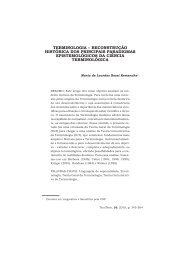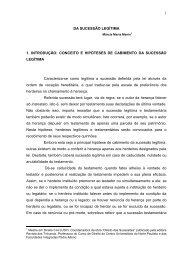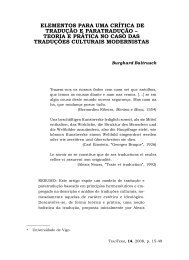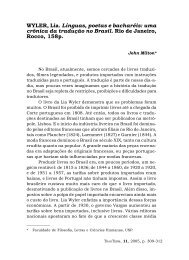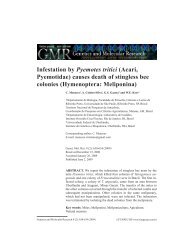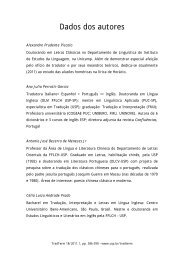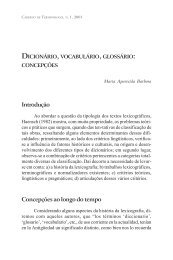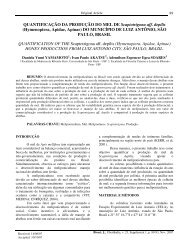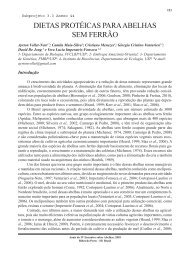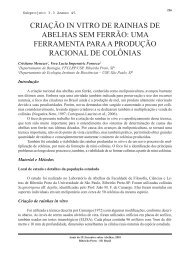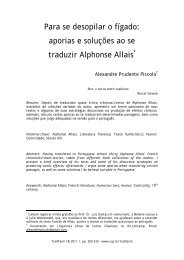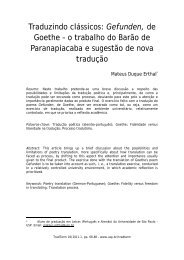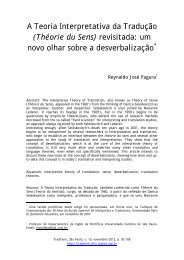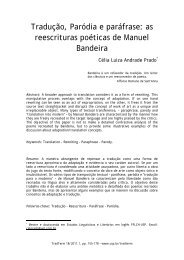Bees as pollinators in Brazil - USP
Bees as pollinators in Brazil - USP
Bees as pollinators in Brazil - USP
You also want an ePaper? Increase the reach of your titles
YUMPU automatically turns print PDFs into web optimized ePapers that Google loves.
32<br />
geneity of the forest community, which should<br />
be understood beforehand. The size of the transects<br />
should be such that they can be covered<br />
<strong>in</strong> one day. They should be 100 m long.<br />
The sampl<strong>in</strong>g units will be flower<strong>in</strong>g<br />
plants, with all bees found be<strong>in</strong>g collected at<br />
all the flower<strong>in</strong>g plants that they visit. Hand<br />
nets will be the pr<strong>in</strong>cipal collection method<br />
and will be complemented by eugloss<strong>in</strong>e baits.<br />
Additional methods such <strong>as</strong> pan, malaise and<br />
light traps and also new baits such <strong>as</strong><br />
salt/ammonia and antifreeze should be tried.<br />
Sampl<strong>in</strong>g should be repeated 3 to 5 times<br />
a month for 8 to 12 months per year, depend<strong>in</strong>g<br />
on flower<strong>in</strong>g phenology and flower density.<br />
Monitor<strong>in</strong>g<br />
The goal of the suggested monitor<strong>in</strong>g program<br />
is to detect differences <strong>in</strong> bee diversity <strong>in</strong><br />
disturbed and undisturbed forests over time. It<br />
could also be used to compare different<br />
degrees of disturbance.<br />
Sampl<strong>in</strong>g units are similar to those used <strong>in</strong><br />
the survey. Monitor<strong>in</strong>g subjects may be selected,<br />
b<strong>as</strong>ed on survey results. For example,<br />
eugloss<strong>in</strong>es or Melipona. Such subjects a)<br />
<strong>in</strong>clude species sensitive to deforestation; b)<br />
occur <strong>in</strong> large numbers and c) can e<strong>as</strong>ily be<br />
identified. Still other subjects could be considered,<br />
such <strong>as</strong> Apis mellifera, trap-nest<strong>in</strong>g<br />
Centris or specialist taxa.<br />
The monitor<strong>in</strong>g design should <strong>in</strong>clude site<br />
<strong>in</strong> or adjacent to undisturbed area (control),<br />
disturbed area (treatment 1) and <strong>in</strong>termediate<br />
area (treatment 2).<br />
A m<strong>in</strong>imum of five years of sampl<strong>in</strong>g is<br />
needed for conclusions to be drawn.<br />
3) SURVEY OF POTENTIAL POLLINATORS<br />
IN THE BRAZILIAN SAVANNA, AND A<br />
MONITORING PROGRAM TO EVALUATE<br />
THE IMPACT OF GRAZING ON FLOWER<br />
VISITORS´ RICHNESS<br />
Background<br />
The biome of the Cerrado is a gradient of vegetation<br />
physiognomies, <strong>in</strong>clud<strong>in</strong>g open fields,<br />
savann<strong>as</strong> and open-canopy forests. It covers<br />
about 25% of the <strong>Brazil</strong>ian territory and w<strong>as</strong><br />
<strong>in</strong>cluded among the world’s hotspots (Myers,<br />
et al. 2000), for comb<strong>in</strong><strong>in</strong>g high biodiversity<br />
and high rates of disturbance. Until 40 years<br />
ago the Cerrado w<strong>as</strong> primarily used for extensive<br />
cattle rais<strong>in</strong>g. By 1988 Kl<strong>in</strong>k & Moreira<br />
(2002) estimated that 35% of the natural<br />
cover had already been removed. In a recent<br />
study, us<strong>in</strong>g MODIS satellite images of 2002,<br />
(Machado, et al.,2004) concluded that the na -<br />
tural cover loss h<strong>as</strong> changed to 55% .<br />
Agriculture occupies 6% of the total area,<br />
but this figure is <strong>in</strong>cre<strong>as</strong><strong>in</strong>gly stimulated by<br />
present national agricultural policy. P<strong>as</strong>tures<br />
and large plantations of soybean and cotton<br />
are the major threats for the biome, caus<strong>in</strong>g<br />
soil loss, water pollution, habitat loss, habitat<br />
fragmentation, <strong>in</strong>troduction and spread of<br />
very agressive <strong>in</strong>v<strong>as</strong>ive species, like African<br />
gr<strong>as</strong>ses, among others (Buschbacher, 2000;<br />
Fearnside, 2001; Kl<strong>in</strong>k & Machado, 2005).<br />
Forec<strong>as</strong>t is not optimistic, accord<strong>in</strong>g to Ma -<br />
chado, et al. (2004), b<strong>as</strong>ed on present vegetation<br />
removal rates by 2030 the whole biome<br />
may have given place to agricultural and cattle<br />
rais<strong>in</strong>g activities.<br />
Major impacts on <strong>poll<strong>in</strong>ators</strong> are apparently<br />
caused by <strong>in</strong>tense use of chemicals, aerial<br />
spray<strong>in</strong>g, and habitat removal; the latter<br />
provokes reduced nest<strong>in</strong>g opportunities and<br />
food availability.<br />
Accord<strong>in</strong>g to Silberbauer-Gottesberger<br />
and Eiten (1987), the plant species richness of<br />
the Cerrado open are<strong>as</strong> is among the highest<br />
known for non-forest vegetation. Se<strong>as</strong>ons are<br />
very well def<strong>in</strong>ed. The dry se<strong>as</strong>on l<strong>as</strong>ts from 3<br />
to 5 months, dur<strong>in</strong>g w<strong>in</strong>ter, and the wet se<strong>as</strong>on<br />
peaks <strong>in</strong> December-January. Flower<br />
resource availability varies through the se<strong>as</strong>ons



